|
June 2009
BLS 125th Anniversary
The Bureau of Labor Statistics (BLS) celebrates its 125th anniversary in 2009. In 1884, Congress voted to establish a Bureau of Labor, and on June 27 of that year President Chester A. Arthur signed the bill into law. A few years later the name of the organization was changed to Bureau of Labor Statistics. Eventually BLS became part of the Department of Labor when the Department was established in 1913.
In honor of this anniversary, BLS is shining the spotlight on a sample of its products.

BLS Headquarters in Washington, D.C.
Consumer Prices
The Consumer Price Index (CPI) is one of the oldest BLS products. The percent change in the index is often referred to as “the inflation rate.” The CPI was initially begun to measure rates of inflation in ship-building centers during WWI, so that cost-of-living adjustments in wages could be calculated.
The CPI is now one of the most widely used measures of inflation in the U.S. Over 80 million individuals are affected by cost of living adjustments determined by the CPI, including Social Security beneficiaries. The CPI is also used to adjust the Federal income tax structure to prevent inflation-induced increases in taxes. In addition to overall inflation, the CPI program measures percent changes in prices for hundreds of individual consumer goods and services.
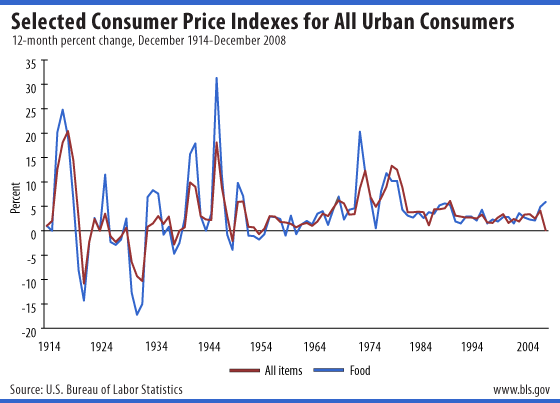
Source: Consumer Price Index (CPI) | Chart Data
Producer Prices
BLS also measures changes in the prices received by producers of goods and services — Producer Price Indexes (PPI). Formerly called the Wholesale Price Index, the name was modified in 1978 to more accurately reflect the changing economy. The chart below shows over-the-year price changes for the three major producer price indexes: finished goods (completed products ready for sale to retailers or the consumer); intermediate goods (commodities that have been processed but require further processing and nondurable, physically complete commodities purchased by business firms as inputs for their operations); and crude goods (farm products and raw materials). Producer prices are typically more volatile than consumer prices, particularly at the crude stage of processing.
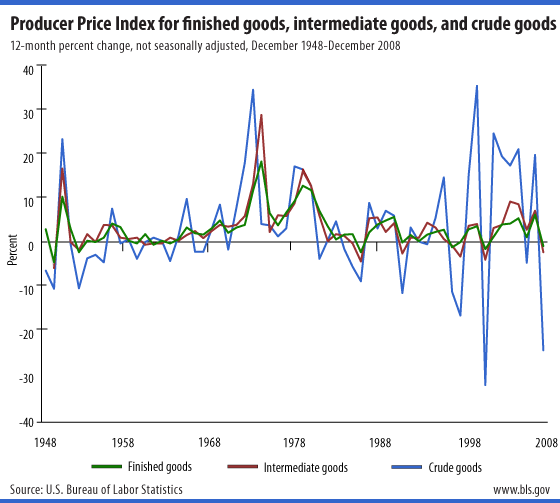
Source: Producer Price Indexes (PPI) | Chart Data
Unemployment Rate
One of the most closely watched numbers from BLS is the national unemployment rate. It is released monthly, usually on the first Friday of the month. The rate is derived using responses from a sample of about 60,000 households; the data are collected by personal and telephone interviews. In addition to the overall unemployment rate, BLS calculates unemployment rates for many different groups of people — by age, race, gender, education, occupation, and so on.
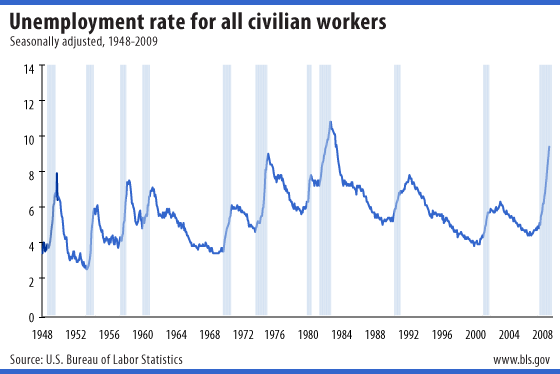
Source: Current Population Survey (CPS) | Chart Data
NOTE: Shaded areas represent recessions as determined by the National Bureau of Economic Research (NBER). NBER has not yet determined an endpoint for the recession that began in Dec. 2007.
Employment
Like the unemployment statistics, payroll employment figures from BLS garner much attention each month. These numbers come from a survey of about 150,000 businesses and government agencies, representing approximately 390,000 individual worksites. In addition to employment figures by industry, the payroll survey also yields hours and earnings statistics for many U.S. industries, as well as data for states and metropolitan areas.
The chart below illustrates how total nonfarm employment has grown by about 100 million since 1939. It also illustrates fluctuations in employment during economic recessions and expansions.
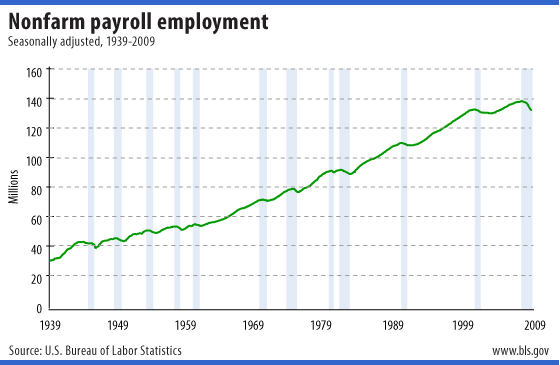
Source: Current Employment Statistics | Chart Data
NOTE: Shaded areas represent recessions as determined by the National Bureau of Economic Research (NBER). NBER has not yet determined an endpoint for the recession that began in Dec. 2007.
Employment Cost Index
BLS began collecting information about worker pay shortly after its creation. For example, in 1888 the Bureau issued a study, “Working women in large cities,” that reported on wages and other matters affecting working women. The most prominent BLS statistic pertaining to worker pay is now the Employment Cost Index (ECI). The ECI shows percent changes in employee compensation and its two components — wages and salaries, and benefits — with some of the numbers going back to the 1970s. The ECI is used for many purposes, such as adjustments to Medicare reimbursements for hospital, physician, and related services.
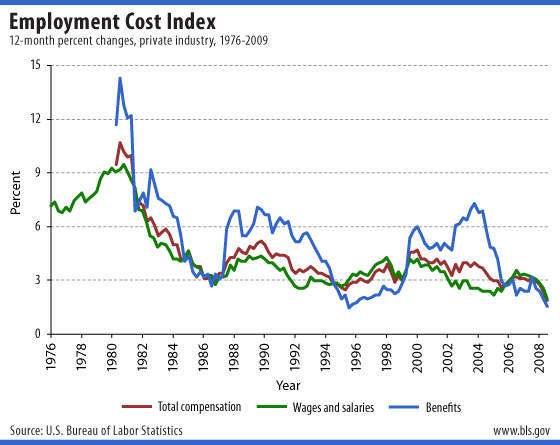
Source: Employment Cost Trends | Chart Data
Productivity
Another prominent BLS statistic is productivity, which is measured as output per hour worked. Capital-intensive investment, improvements in technology, and better skilled workers are some of the major sources of labor productivity growth in the long term. Labor productivity has grown at an average annual rate of 2.2 percent in the nonfarm business sector during the past 60 years.
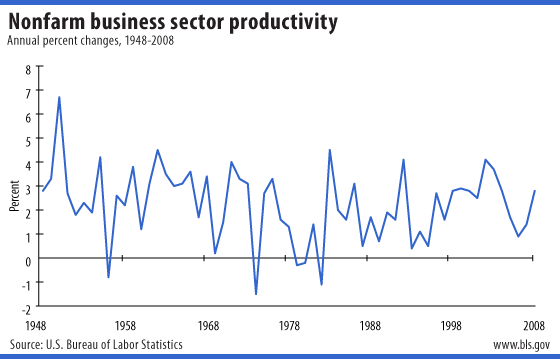
Source: Labor Productivity and Costs | Chart Data
Injuries, Illnesses, and Fatalities Statistics
An early concern of the Bureau of Labor Statistics was measuring the rate at which workers are injured or become ill on the job. This is still an important area of study for BLS, and each year the Census of Fatal Occupational Injuries and the Survey of Occupational Injuries and Illnesses are conducted to provide the latest information on this topic. The chart below shows how the overall nonfatal injury and illness rate has declined in private industry in the U.S. since the early 1970s.
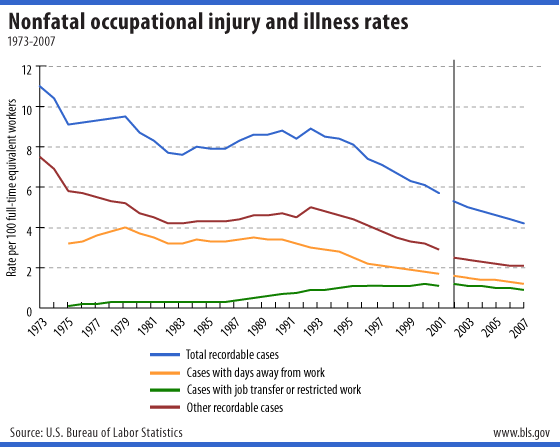
Source: Injuries, Illnesses, and Fatalities | Chart Data
NOTE: There was a break in series in 2002 due to a change in the recordkeeping requirements of the Occupational Safety and Health Administration (OSHA).
Job Openings and Labor Turnover Survey
One of the newest BLS programs is the Job Openings and Labor Turnover Survey (JOLTS). Series from this survey begin in December 2000. This survey provides measures of job openings, hires, and separations, as shown below. The number of job openings is an important measure of the unmet demand for labor. When used in conjunction with the unemployment rate, it provides a more complete picture of the U.S. labor market.
It may be surprising to see in the chart below that separations — which consist of quits, layoffs and discharges, and other separations such as retirements — have not increased during the current recession. This is because the increase in involuntary separations (layoffs) has been more than offset by a sharper decline in voluntary separations (quits).
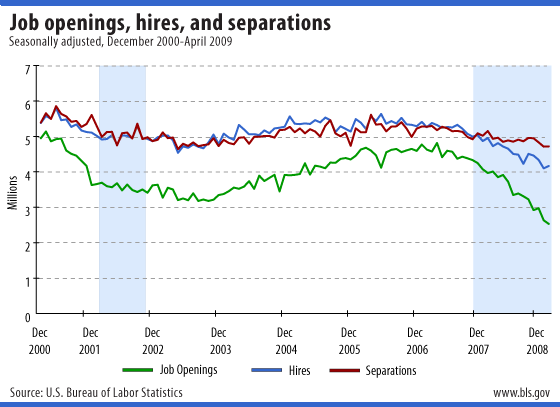
Source: Job Openings and Labor Turnover Survey | Chart Data
NOTE: Shaded areas represent recessions as determined by the National Bureau of Economic Research (NBER). NBER has not yet determined an endpoint for the recession that began in Dec. 2007.
Geographic Data
In addition to national data, BLS publishes many statistics about states, metropolitan areas, and counties. For example, the unemployment rates for all of those types of geographic areas are available from the Local Area Unemployment Statistics program. The map below shows preliminary state unemployment rates for May 2009.
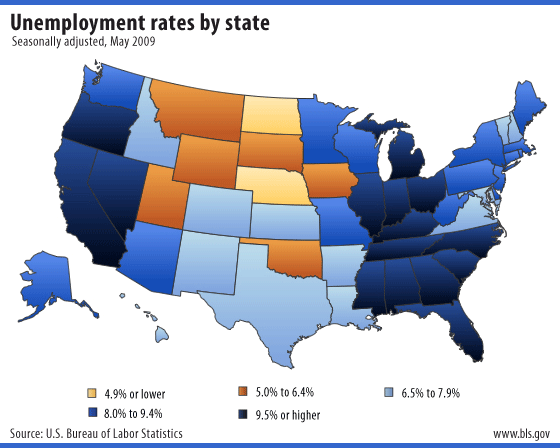
Source: Local Area Unemployment Statistics | Chart Data
Occupational Outlook Handbook
Although it's not a survey, the Occupational Outlook Handbook (OOH) is one of the best known products of the Bureau of Labor Statistics. First published shortly after World War II, the OOH has been used by generations of students to help them plan their careers. Each edition is packed with valuable information about hundreds of occupations, including their job tasks, working conditions, educational and training requirements, employment and wages, and prospects for the future.

Source: Occupational Outlook Handbook
More information:
BLS Surveys and Programs:
In addition to the national office in Washington, DC, BLS also has eight information offices around the country, ready to provide assistance in locating or understanding BLS numbers:
BLS Regional Offices:
Lastly, find out more about BLS history in “The First Hundred Years of the Bureau of Labor Statistics”
Note: Data in text, charts and tables are the latest available at the time of publication. Internet links may lead to more recent data.
General Information: (202) 691-5200
Media Contact: (202) 691-5902
|